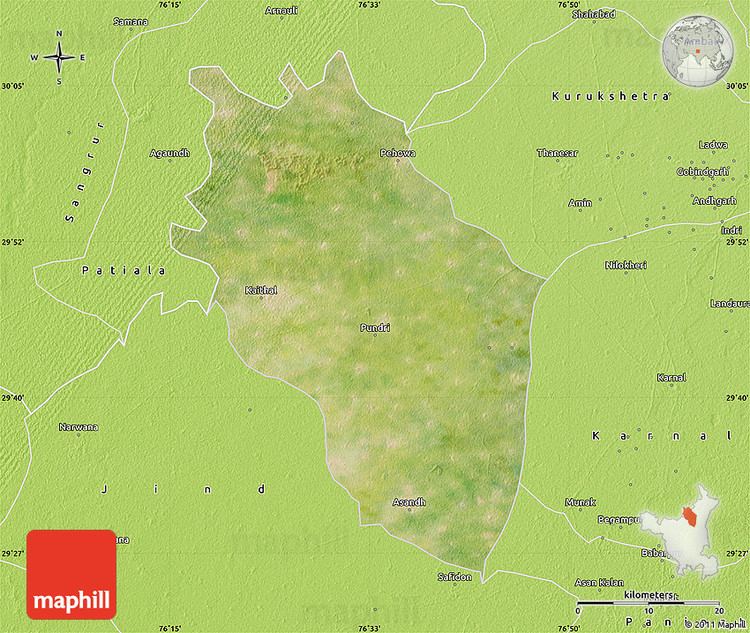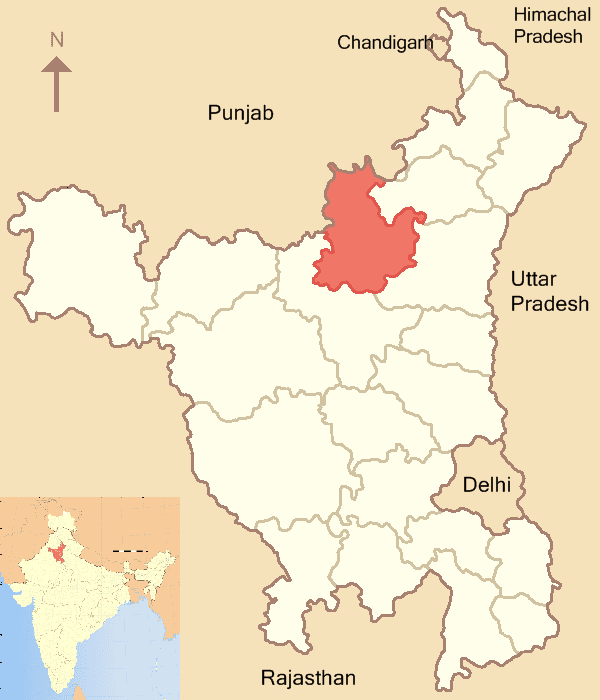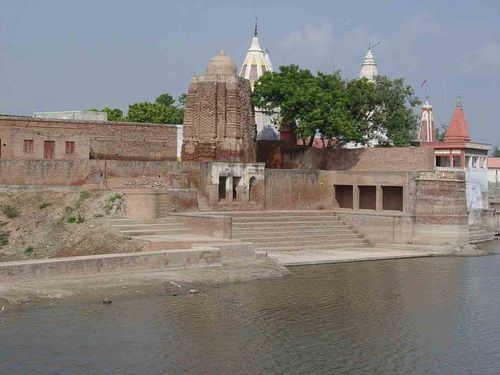Country Languages spoken District Kaithal | State | |
 | ||
University RKSD College of Pharmacy | ||
Map of Kaithal
Kaithal (Hindi: कैथल) is a city and a municipal council in Kaithal district in the Indian state of Haryana. Kaithal was previously a part of Karnal District and later, Kurukshetra District until 1 November 1989, when it became the headquarters of the Kaithal District of Haryana. Kaithal shares common boundary with Patiala (Punjab), Kurukshetra, Jind and Karnal. Kaithal district is situated in the North-West of the Haryana state. Its North-West boundaries which include Guhla-Cheeka is attached to Punjab State.
Contents
- Map of Kaithal
- Sagar challana cheeka kaithal guhla
- Geographics
- Mythology
- History
- Sikh rule in Kaithal
- Demographics
- Kaithal Fort
- Tomb of Razia Sultana
- One of the highest flag of India
- 48 Kos Temples
- Vidkyar Teerth Vriddh Kedaar
- Shree Gyarah Rudri Mandir
- Anjani Teela
- Ancient Khandeshwar Temple
- Gyrah Rudri Shiva Temple
- Other Temples
- Gurudwaras
- Islamic religious places
- Dharamshalas
- Transport
- Government Schools
- Private Schools
- Notable people
- Inalsa food processor maxie plus demo
- Rarely seen adani agro logistics bulk food grain rake with asansol wag5 twins
- References

Sagar challana cheeka kaithal guhla
Geographics

Kaithal is located at 29.8015°N 76.3996°E / 29.8015; 76.3996. It has an average elevation of 220 metres (721 feet).
Mythology
Historically, it was known as Kapisthal, meaning "Abode of Kapi", another name of Lord Hanuman, and it is said to have been founded by the Pandava Emperor, Yudhishthira of Mahabharata. It is traditionally connected with Hanuman, and has a temple dedicated to [[Añjanā |Anjani]], the mother of Hanuman. It is also said that it is the birthplace of Lord Hanuman (refuted claim as sources point hanuman's bithplace and kishkinda city to hampi,karnataka.) and there is a temple constructed at that place known as "Anjani Tila" among the residents of Kaithal.
The Vridhakedara (Vidkyar) sanctum of Kaithal finds a mention in Vedic texts of Vaman Puran.
Kaithal, with many of its temples, is also an important milestone in 48 Kos Parikrama pilgrimage.
History
Timur stopped here in 1398, before attacking Delhi. Later, the city became a Muslim cultural centre, under the rule of Delhi Sultanate. Tombs of several Sufi saints dating from the 13th century can be found in the city today; most important among them is that of Sheikh Sala -ud-din of Bhalkh (1246 CE). The town was renovated and a fort was built during the rule of the Mughal Emperor, Akbar, and as per Ain-i-Akbari, it was a pargana, under the sarkar of Sirhind, and had developed into an agricultural centre
Razia Sultana, the first woman ruler of India, reigned as the Sultana of Delhi Sultanate from 1236 to 1240. She fled Delhi with Malik Altúniya after they were defeated on the 24th of Rabí'u-l awwal A.H. 638 (Oct. 1240), and reached Kaithal the next day, where their remaining forces abandoned them, and they both fell into the hands of the Hindus and were killed on Nov. 13, 1240. Tomb of Rajia Begam is still found here. This aspect is still not well known outside Kaithal, but residents know about the mazaar of Razia Begum even generations later.
Sikh rule in Kaithal
In 1767, it fell into the hands of the Sikh chieftain, Bhai Desu Singh (d. 1781), who led a large Sikh force from his native village of Bhucho, In the Punjab. whose descendants, the bhais of Kaithal, ranked among the most powerful Cis-Sutlej states. The Sikh Chieftains of Kaithal, ruled from 1767 until Its fall, In 1843. By 1808, It came under British Influence. The state was ruled by the Scindhia dynasty of the Maratha Empire and paid tributes to the Marathas, until the Second Anglo-Maratha War of 1803-1805, after which the Marathas lost this territory to the British. Bhai Udey Singh ruled over Kaithal and proved as the last King. Bhai Udey Singh died on 14 March 1843. It became a municipality in 1867. In 1901, the town had a population of 14,408 and was the tehsil in the district of Karnal. The fort of the Bhais is still extant, and their title Bhai became common with the primary Sikh rulers. Peoples of Kaithal took active part in freedom struggle in 1857.
Demographics
As of the 2011 India census, Total population of Kaithal is 9,45,631. The sex ratio is 887 (F/M) and 11.5% of the population is under six years of age. The effective literacy rate is 80.76%; male literacy is 87.65% and female literacy is 73.07%. Punjabi & Hindi are major languages. There are 277 villages and 253 Punchayats in Kaithal districts. Kaithal district consists of two sub-divisions two tehsils namely Kaithal & Guhla & five sub-tehsils namely Pundri, Rajaund, Dhand, Kalayat and Siwan. The name of Kaithal, Pundri, Pharal, Siwan and Kalayat show that the soil of Kaithal has been religious and cultural rich heritage.
Kaithal Fort
There exist remains of the fort of the Bhais, and several Muslim tombs of the 13th century and later. The Kaithal fort has many gates made by British rulers and used to control the entry of trade goods and other items.
As on 2016, the fort has now been restored and renovated (as seen in pictures). It now forms one of the most visible and importamnt landmarks of Kaithal.
Tomb of Razia Sultana
Tomb of Razia Sultana, who gained the throne of Delhi Sultanate under the Mamluk Sultanate, is situated 10 km north-west of the Kaithal city in Siwan on Kaithal-Cheeka-Patialaroad. It is close to the jail constructed nearby by the present administration. She and her husband Malik Altunia who was the governor of Bhatinda (Punjab) were decapitated by the local Jat people of area. It is speculated that she might have been disinterred form Kaithal and then reburied at her Delhi's tomb.
Raziya al-Din (1205 in Budaun – October 13, 1240), throne name Jalâlat ud-Dîn Raziyâ, usually referred to in history as Razia Sultana, was the Sultan of Delhi in India from 1236 to May 1240. Like some other Muslim princesses of the time, she was trained to lead armies and administer kingdoms if necessary. Razia Sultan was the only woman ruler of both the Sultanate and the Mughal period, although other women ruled from behind the scenes. Razia refused to be addressed as Sultana because it meant "wife or consort of a Sultan". She would answer only to the title "Sultan."
One of the highest flag of India
In Kaithal a 22-by-14.6-metre (72 by 48 ft) national flag is hoisted 63 metres (207 ft) above the ground in Hanuman Vatika.
48 Kos Temples
Following two pilgrimage points of Kaithal town form part of Kurukshetra's 48 kos pariktrama.
Vidkyar Teerth (Vriddh Kedaar)
Vriddh Kedaar or Vidkyaar as it is popularly known is an important religious place for Hindus. This is one of the several piligrimages in 48 kos parikrama of Kurukshetra. This pilgrimage has been mentioned in ancient text of Vamana Purana also.
Vaman Purana says :
"Kapisthaleti vikhyatam sarvapatakanashanam yasmina sthitaha swayam devovridha kedara samgjijitaha" (2)
(Translation: The destroyer of all devilish deeds, the famous Kapisthala sanctum is here because Lord Vridhakedara himself resides in it.) The Vridhakedara sanctum changed to "Vidkyara" as a result of the philological principle of "mukhasukha", or ease of speaking. it is located near pehowa chowk, the central point of Kaithal.
Shree Gyarah Rudri Mandir
It is one of the famous temple of city, where divine eleven Rudra were placed before 5000s years ago and the temple is known for its art, architecture, beautiful scriptures and large area, a big statue of hanumaan compliments the beauty of this temple.
Anjani Teela
Anjani was the name of mother of lord Hanuman. Kaithal was earlier as Kapisthal, the abode of monkeys (or monkey God, Hanuman).
Ancient Khandeshwar Temple
This is an ancient temple dedicated to Lord Shiva. It is located in khadalwa, matour village, kalayat. Only a few know that it is one of the 64 jyotirlings. Its present building is new but the jyotirling is here from ancient times. It is also a part of 48 kos yatra of kurukshetra.
Gyrah Rudri Shiva Temple
Out of 108 Shiva Temples situated in the city, Gyrah-Rudri Temple is the most famous one of its own kind. Legend has it that it is at this place during Mahabharta era, Arjun had been conferred Pashupat Astra by praying to Lord Shiva. Present day Temple was constructed about 250 years ago by wife of the then ruler of Kaithal Bhai Udai Singh. The Temple has 11 Shivlings and is considered most pious.
Other Temples
Gurudwaras
Islamic religious places
Sheikh Tayyab actual name was Lala Maidni Mal and he was one of the advisor to Mughal Emperor Akbar. He converted to Islam at the hands of Hazrat Shah Kamal Qadri. His descendants from Hindu wife are called "Qanugo" and the place where they used to live is called Mohalla "Qanugoyan" in Kaithal. There was a tradition when some one from Qanugo used to get married, they used to send one pitcher of sweet drink (sherbat) to sheikh Tayyab masjid (also known as masjid of mirrors)
and one pitcher to Hazrat baba shah Kamal shrine.
Once there was famine in the times of Hazrat shah kamal. When he came to know about it, he asked to prepare Two big pots of special food (Dalya). One was prepared by a Muslim and the other one was prepared by a Hindu brahman. It was announced that people from all over the city can come and eat day and night and take away this Dalya to their homes as well. There was a miracle that despite thousands of people eating from this langar, big pots were still filled with food. When famine ended, this food was also discontinued.
After that incident, it was a tradition that every year in the month of "sawan" rainy season, on all four Thursdays of rainy season, people of every religion used to get this special food "dalya" prepared and send it to the dargah of baba shah kamal to be distributed among the needful.
Dharamshalas
Transport
The city is connected to the state capital Chandigarh through National Highway 152. The city have two railway stations named; Kaithal (KLE) and New Kaithal Halt (NKLE). The city had a rail connection to Kurukshetra and Narwana which further went to Jind (local trains only) until 2014, when government started a rail service between Delhi and Kurukshetra via Kaithal. The move for this service was initiated and pushed by the previous Member of Parliament from Kurukshetra, Naveen Jindal with an aim to give people a convenient mode of transport to reach the capital. Earlier they had to board trains at the Kurukshetra railway station. In 2015, a new express train connecting Chandigarh and Jaipur via Kaithal has been started.
